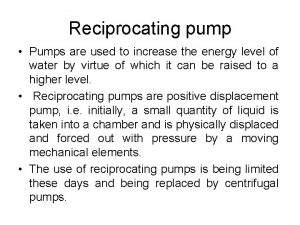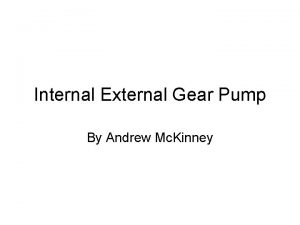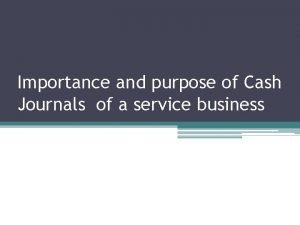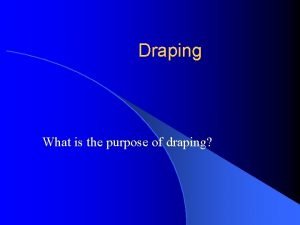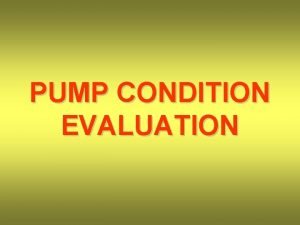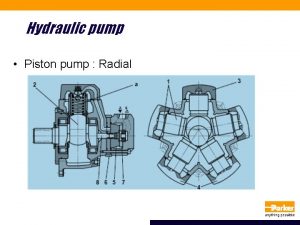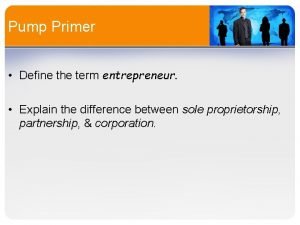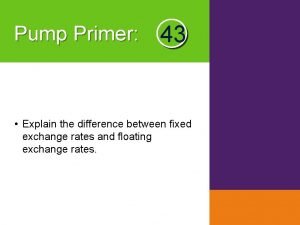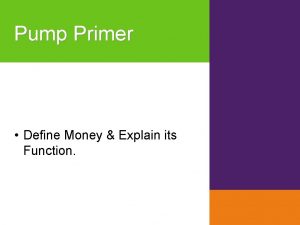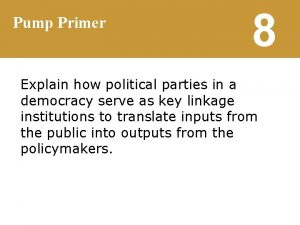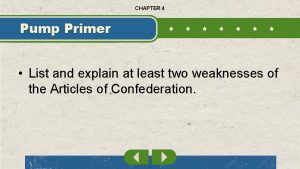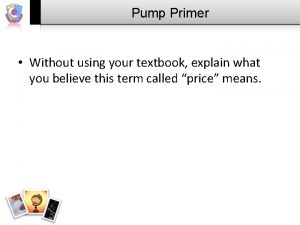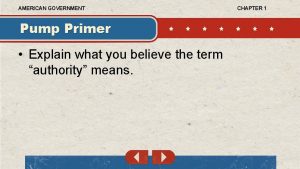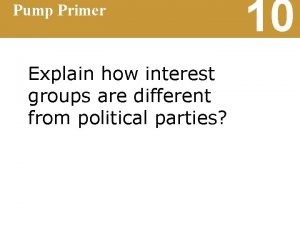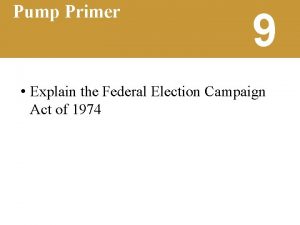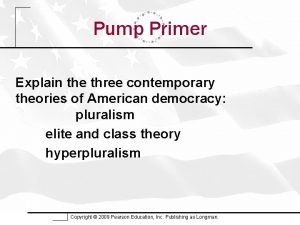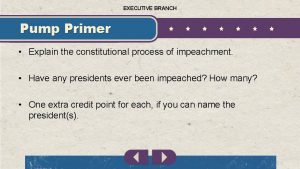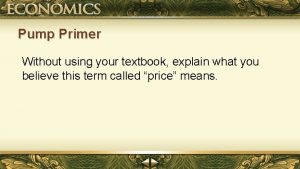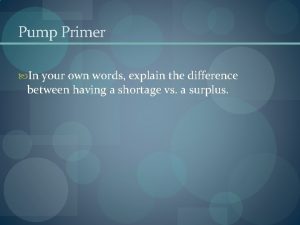Pump Primer 26 Explain the general purpose of



















- Slides: 19

Pump Primer: 26 • Explain the general purpose of the Federal Reserve System.

Module 26 The Federal Reserve System: History and Structure KRUGMAN'S MACROECONOMICS for AP* Margaret Ray and David Anderson

Biblical Integration • Christians need to hold the government accountable for the wealth of our nation. We need to be responsible with the money that comes into our possession, using it wisely and in a way that is pleasing unto God. For God is the owner of the world's wealth, His ability to distribute it as He sees fit, and His use of it to provide for the needs of His children.

What you will learn in this Module: • The history of the Federal Reserve System • The structure of the Federal Reserve System • How the Federal Reserve has responded to major financial crises

The Federal Reserve System • The Federal Reserve is a central bank—an institution that oversees and regulates the banking system, and controls the monetary base.

An Overview of the Twenty-first Century American Banking System • Like many things in government and business, our current Federal Reserve is a product of our history. • When our banks and economies went through periods of crisis, government created various laws and bureaucracy to oversee the system and protect borrowers and lenders.

Crisis in American Banking at the Turn of the Twentieth Century The creation of the Federal Reserve System in 1913 marked the beginning of the modern era of American banking. Though banks were federally regulated since 1864, there were still fundamental problems delivering money from large banks in big cities to smaller banks in rural communities. If a rural bank in Indiana or Wisconsin was low on reserves, the bank may fail before money could be delivered to the bank. This bank failure could spark a run on several banks, devastating local communities. Note: Details of the Panic of 1907 will not be tested on the AP exam.

Crisis in American Banking at the Turn of the Twentieth Century Panic of 1907 The crisis originated in institutions in New York known as trusts, bank-like institutions that accepted deposits but that were originally intended to manage only inheritances and estates for wealthy clients. Trusts were supposed to engage only in low-risk activities = they were less regulated, had lower reserve requirements, and had lower cash reserves than national banks However, as the American economy boomed during the first decade of the twentieth century, trusts began speculating in real estate and the stock market, areas of speculation forbidden to national banks. Less regulated than national banks, trusts were able to pay their depositors higher returns.

Crisis in American Banking at the Turn of the Twentieth Century Trusts grew rapidly. They declined to join the New York Clearinghouse, a consortium of New York City national banks that guaranteed one another’s soundness; that would have required the trusts to hold higher cash reserves, reducing their profits.

Crisis in American Banking at the Turn of the Twentieth Century The Panic of 1907 began with the failure of the Knickerbocker Trust, a large New York City trust that failed when it suffered massive losses in unsuccessful stock market speculation. Within two days, a dozen major trusts had gone under. Credit markets froze, and the stock market fell dramatically as stock traders were unable to get credit to finance their trades and business confidence evaporated. Fortunately, New York City’s wealthiest man, the banker J. P. Morgan, quickly stepped in to stop the panic. He worked with other bankers, wealthy men such as John D. Rockefeller, and the U. S. Secretary of the Treasury to shore up the reserves of banks and trusts so they could withstand the onslaught of withdrawals. Once people were assured that they could withdraw their money, the panic ceased. Although the panic itself lasted little more than a week, it and the stock market collapse decimated the economy. A four - year recession ensued, with production falling 11% and unemployment rising from 3% to 8%.

Responding to Banking Crises: The Creation of the Federal Reserve In 1913 the national banking system was eliminated and the Federal Reserve System was created as a way to compel all deposit-taking institutions to hold adequate reserves and to open their accounts to inspection by regulators. The Panic of 1907 convinced many that the time for centralized control of bank reserves had come. In addition, the Federal Reserve was given the sole right to issue currency in order to make the money supply sufficiently responsive to satisfy economic conditions around the country.

The Structure of the Fed Strictly speaking, the Federal Reserve System consists of two parts: the Board of Governors and the 12 regional Federal Reserve Banks. Oversees the entire system from offices in Washington, D. C. , is constituted like a government agency: its seven members are appointed by the president and must be approved by the Senate.

The Structure of the Fed

The Structure of the Fed Board of Governors Members are appointed for 14 -year terms, to insulate them from political pressure in their conduct of monetary policy. The chairman is appointed more frequently—every four years—but it is traditional for the chair to be reappointed and serve much longer terms. The 12 Federal Reserve Banks each serve a region of the country, providing various banking and supervisory services.

The Structure of the Fed 12 Regional Banks Each regional bank is run by a board of directors chosen from the local banking and business community. The Federal Reserve Bank of New York plays a special role: it carries out open -market operations, usually the main tool of monetary policy. Decisions about monetary policy are made by the Federal Open Market Committee, which consists of the Board of Governors plus five of the regional bank presidents. The president of the Federal

The Structure of the Fed Reserve Bank The president of New York is always on the committee, and the other four seats rotate among the 11 other regional bank presidents. The chairman of the Board of Governors normally also serves as the chairman of the Open Market Committee.

The Effectiveness of the Federal Reserve System Creation of the Fed didn’t stop bank runs and it didn’t stop the Great Depression. A series of economic downturns and damaging bank runs instigated new laws from Congress that attempted to stabilize the banking industry and provide safeguards for the public and their deposits. However, when the Great Depression became a distant memory and bank runs became much less common, Congress let some of the regulations of the 1930 s lapse. Some of these legal lapses created problems in the 1980 s and in 2008.

The Savings and Loan Crisis of the 1980 s • Savings and Loans (Thrifts) • Political Interference • Tax-Payers • Inflation’s effect on the S&Ls • Speculation • Comprehensive Oversight

Back to the Future: The Financial Crisis of 2008 1. Long - Term Capital (Mis)Management 2. Subprime Lending and the Housing Bubble 3. Crisis and Response
 Slip of a reciprocating pump is defined as the *
Slip of a reciprocating pump is defined as the * Internal external gear pump
Internal external gear pump Internal gear pump advantages and disadvantages
Internal gear pump advantages and disadvantages General purpose specific purpose central idea
General purpose specific purpose central idea Objetivo general de las ecuaciones lineales
Objetivo general de las ecuaciones lineales The purpose of narative text
The purpose of narative text What is the purpose of cash journal
What is the purpose of cash journal Strip draping
Strip draping Tee joint definition
Tee joint definition Find s algorithm machine learning
Find s algorithm machine learning Hát kết hợp bộ gõ cơ thể
Hát kết hợp bộ gõ cơ thể Slidetodoc
Slidetodoc Bổ thể
Bổ thể Tỉ lệ cơ thể trẻ em
Tỉ lệ cơ thể trẻ em Chó sói
Chó sói Chụp tư thế worms-breton
Chụp tư thế worms-breton Hát lên người ơi
Hát lên người ơi Các môn thể thao bắt đầu bằng tiếng đua
Các môn thể thao bắt đầu bằng tiếng đua Thế nào là hệ số cao nhất
Thế nào là hệ số cao nhất Các châu lục và đại dương trên thế giới
Các châu lục và đại dương trên thế giới
